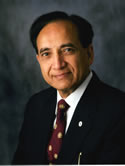Encapsulated thyroid tumors of follicular cell origin with high grade features (high mitotic rate/tumor necrosis): A clinicopathologic and molecular study Journal Article
| Authors: | Rivera, M.; Ricarte-Filho, J.; Patel, S.; Tuttle, M.; Shaha, A.; Shah, J. P.; Fagin, J. A.; Ghossein, R. A. |
| Article Title: | Encapsulated thyroid tumors of follicular cell origin with high grade features (high mitotic rate/tumor necrosis): A clinicopathologic and molecular study |
| Abstract: | Encapsulated thyroid tumors of follicular cell origin with high-grade features (EFHG) are unusual neoplasms. In current classification schemes, they are called atypical adenomas or follicular, papillary, or poorly differentiated carcinoma. When noninvasive, EFHG create a major therapeutic/diagnostic dilemma stemming from their rarity, low-stage, high-grade appearance, and lack of long-term follow-up studies. All cases of EFHG were defined as encapsulated tumors of follicular cell origin with at least 5 mitoses per 10 high-power fields and/or tumor necrosis. Available tissues were subjected to a thyroid carcinoma platform for mass spectrometry high-throughput genotyping, which consisted of 111 known mutations in 16 different genes: BRAF, RET, NRAS, HRAS, KRAS, PIK3CA, AKT1, and other related genes. Twenty-five cases met the selection criteria. Tumor necrosis was present in 56.0% (n = 14). Extensive vascular invasion was identified in 24.0% (n = 6). Eight (32%) of 25 tumors were noninvasive. Twenty-two patients (88%) were free of disease (median follow up: 8.5 years). All 8 noninvasive tumor did not recur despite focal/extensive tumor necrosis in 3 cases and a median follow-up of 11.9 years. EFHG with no vascular invasion did not recur. In patients without distant metastases at presentation (n = 24), 33% (2/6) of patients with extensive angioinvasion relapsed, whereas none of 18 with absent/focal vascular invasion recurred (P = .054). Mutations were found in 10 (45%) of 22 cases tested: 8 had NRAS codon 61, 1 KRAS codon 61, and 1 had coexistent BRAF V600E and AKT1. There was a higher frequency of RAS (9/22, 41%) than BRAF mutations (1/22, 4.5%) (P = .009). Noninvasive EFHG have an indolent behavior even in the presence of extensive tumor necrosis. EFHG with absent vascular invasion have an excellent prognosis despite the frequent occurrence of tumor necrosis. NRAS mutations are the most frequent oncogenic event in EFHG. © 2010 Elsevier Inc. All rights reserved. |
| Keywords: | adolescent; adult; clinical article; human tissue; aged; aged, 80 and over; middle aged; gene mutation; human cell; mutation; clinical feature; histopathology; patient selection; mitosis; mass spectrometry; metastasis; neoplasm recurrence, local; tumor markers, biological; genotype; necrosis; cancer invasion; mitosis rate; thyroid carcinoma; thyroid neoplasms; dna extraction; thyroid follicle cell; thyroid tumor; adenocarcinoma, follicular; thyroid; encapsulation; molecular; tumor necrosis; mitotic index; clinicopathologic; encapsulated; follicular |
| Journal Title: | Human Pathology |
| Volume: | 41 |
| Issue: | 2 |
| ISSN: | 0046-8177 |
| Publisher: | Elsevier Inc. |
| Date Published: | 2010-02-01 |
| Start Page: | 172 |
| End Page: | 180 |
| Language: | English |
| DOI: | 10.1016/j.humpath.2009.08.011 |
| PUBMED: | 19913280 |
| PROVIDER: | scopus |
| PMCID: | PMC4573458 |
| DOI/URL: | |
| Notes: | --- - "Cited By (since 1996): 1" - "Export Date: 20 April 2011" - "CODEN: HPCQA" - "Source: Scopus" |
Altmetric
Citation Impact
BMJ Impact Analytics
MSK Authors
Related MSK Work










